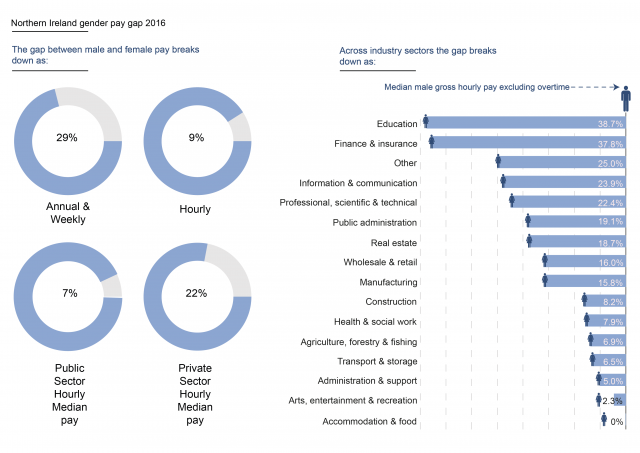By Aidan Stennett & Eóin Murphy
Please note: we have posted a new version of this blog article using the most recent data, see here.
This article examines the gender pay gap in Northern Ireland: what is it, how is it measured and what is the scale across different sectors?

What is the gender pay gap?
The UK Government states that the gender pay gap is:
… an equality measure that shows the difference in average earnings between women and men.
Moreover, it draws an important distinction between the gender pay gap and equal pay, noting:
Paying men and women differently for doing the same or equivalent work is discrimination and has been against the law since the Equal Pay Act was introduced in 1970. While this does still happen in some cases and can be a component of the gender pay gap, it is not the main reason that men and women’s average salaries differ. An employer delivering equal pay may still have a large pay gap, an employer with a small pay gap may be breaching the law.
There are a number of factors which lead to a gender pay gap. Again, these are defined by the UK Government as:
- A higher proportion of women choose occupations that offer less financial reward (e.g. Administration), whilst many high paying sectors are disproportionately made up of male workers (e.g. Information and Communications Technology);
- A much higher proportion of women work part-time, and part-time workers earn less than their full-time counterparts on average; and,
- Women are less likely to progress up the career ladder into high paying senior roles.
The reasons for these factors are complex and overlapping. However, research, such as work carried out by the Institute for Fiscal Studies (IFS), shows that certain elements recur in the literature:
- Work by the IFS found that the pay gap widens in the late 20s, with male wages increasing and female wages flat-lining. This is, the IFS believes, a result of women having children. Following this, the gap continues to widen as women lose out on labour market experience, lowering their future wage potential;
- Women also tend to enter part-time employment following the birth of their first child, reflected in the high number of women working part-time. This part-time working also appears to be persistent. Even after a child has reached the age of 20, women are more likely to remain in part-time employment, potentially reflecting the impact of a loss of labour market experience; and,
- Choice of occupation, as noted above by the UK Government, also plays an important role in the development of a gender pay gap. In broad terms, women tend to work in lower paying sectors.
Importantly, and as noted by the IFS, this does not explain the wage gap prior to the arrival of a woman’s first child.
How is the gender pay gap measured?
The infographic above provides a summary of the gender pay gap in NI in 2016. It uses the Office of National Statistics official measure of a gender pay gap – hourly median pay excluding overtime – and two additional measures: median annual gross pay excluding overtime; and median weekly pay. These additional measures are used to highlight any differences in take-home earnings on a weekly and annual basis.
It also compares the gender pay gap in the NI public and private sectors, and across all broad industry sectors. This sectoral analysis compares male and female hourly median pay, excluding overtime.
Whatever the sector or timescale examined, median pay is used to measure:
… the amount earned by the average individual, i.e. the level of earnings above which half the population fall.
The median is used rather than the mean (another measure of averages). This is because the mean is susceptible to skewing data due to small numbers of very high earners.
Across all measures highlighted in the illustration above the gender pay gap is expressed as the percentage by which female pay is below male pay. For example, female hourly median pay is 7% below male hourly median pay. This is also the case for the sectoral analysis, which is also illustrated in the infographic. For example, female hourly median pay in the education sector is 38.7% below the male equivalent.

